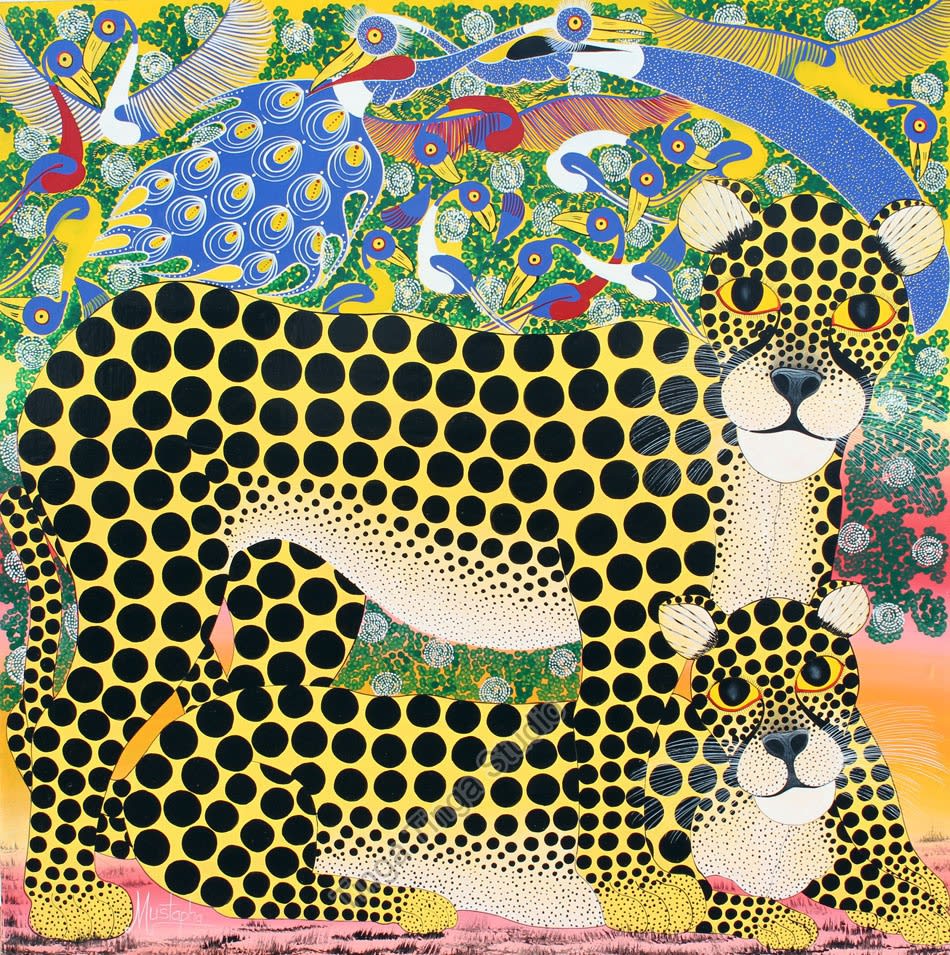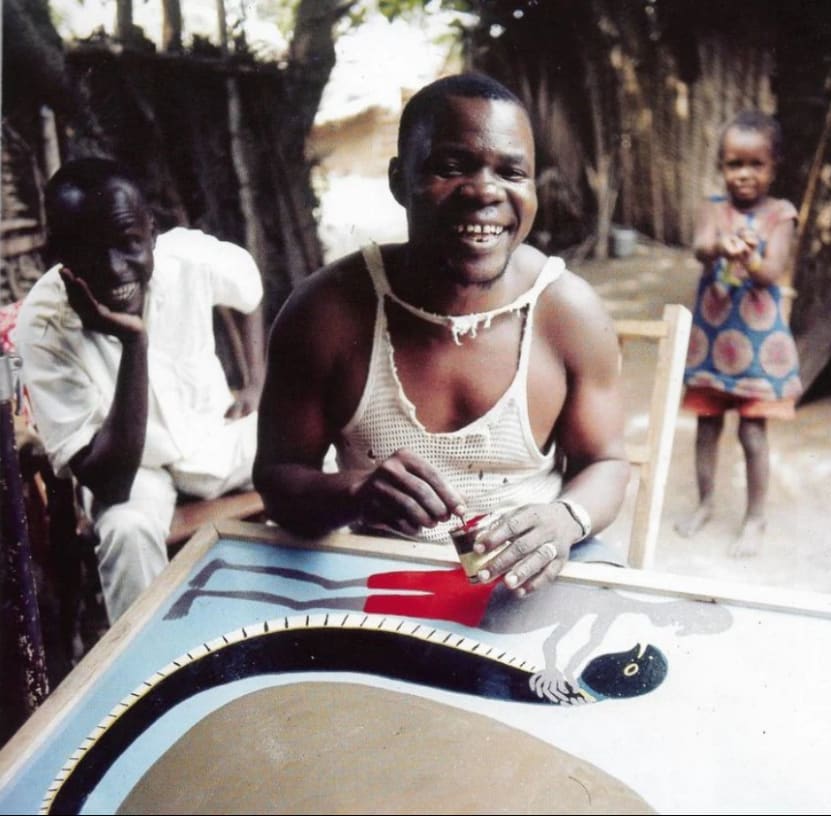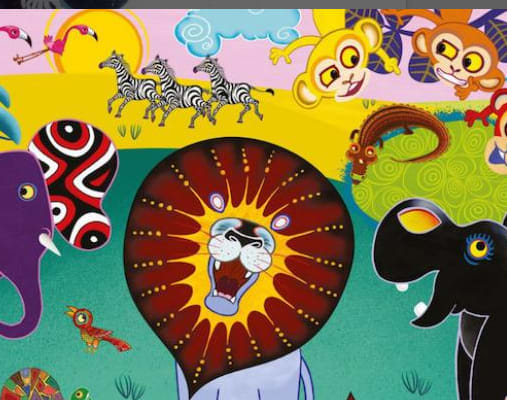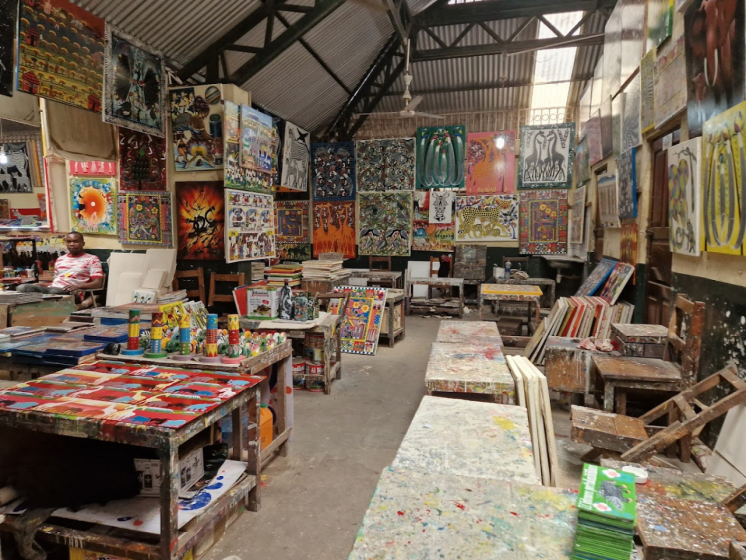
In this article, Pavillon54 explores the world of Tinga Tinga art, a distinct painting style that originated in East Africa, particularly in Tanzania. This vibrant and unique artistic tradition has gained immense popularity among locals and tourists alike, showcasing the rich cultural heritage and natural beauty of the region.
Introduction
Nestled along the shores of the Indian Ocean, Tanzania is an East African nation that boasts a fascinating tapestry of artistic expressions. Its borders embrace the vibrant cultures of Kenya and Uganda to the north, Rwanda, Burundi, and the Democratic Republic of the Congo to the west, and Zambia, Malawi, and Mozambique to the south. Within this melting pot of creativity, one can discover a kaleidoscope of art forms, from the intricate makonde sculptures to the timeless traditional pottery, and the ancient rock paintings that adorn the land. However, among this artistic mosaic, a unique and vibrant style stands out – the Tingatinga art.
What we’ll cover in this article includes:
1.TingaTinga Art: Early Beginnings
3.Significance and Impact of Tinga Tinga Art
4.Tinga Tinga Art Market and Cooperative
Origins and Evolution of Tinga Tinga Art
Early Beginnings
Tingatinga, also known as Tinga-tinga or Tinga Tinga, is a painting style that finds its roots in the heart of East Africa. This genre has become one of the most widely celebrated forms of tourist-oriented art in Tanzania, Kenya, and neighboring countries, capturing the imagination of visitors from far and wide. The name itself pays homage to its founder, the Tanzanian painter Edward Said Tingatinga, whose humble beginnings belie the richness of his artistic legacy.

Edward Tinga Said Tingatinga. Image courtesy of Tingatinga African Art
Born into a family of modest means, Edward's journey began with a unique blend of cultural influences. His mother, Agnes Binti Ntembo, hailed from the Makua ethnic group of southern Tanzania, embracing the Christian faith, while his father, Saidi Tingatinga, belonged to the Ngindo people, upholding the traditions of Islam. This diverse tapestry of backgrounds wove itself into the vibrant threads of Edward's art, creating a distinct style that would leave an indelible mark on the artistic landscape of the region.
Edward's earlier paintings were made using recycled, low-cost materials, such as masonite squares, ceramic fragments, and bicycle paint. His style was naïve, bordering on surrealistic and humorous; most of his subjects were stereotypical African icons, such as wildlife or savannah landscapes. From just being painted on wood and usually was a single animal.
Expansion and Popularity
Tinga Tinga art is painted on almost every material, namely mug cups, trays, fabric, gates, car wheel covers, etc. Initially, Tingatinga style was naive, yet bordering on surrealistic and humorous. He often depicted stereotypical African icons, such as wildlife and savannah landscapes, which quickly gained popularity among European residents and tourists.
Tinga Tinga art transcends the bounds of traditional perspective, inviting the viewer to immerse themselves in a world where form, shape, and colour reign supreme. The artists behind this style have not been bound by the conventions of formal training; instead, their brushstrokes dance to the rhythm of their own unique visions. Guided by the allure of the savannah and the enchantment of its inhabitants, their canvases come alive with vibrant depictions of the animal kingdom.
These works, often referred to as "airport art" for their portability and popularity among travellers, are a testament to the artists' ability to capture the essence of their subjects through bold strokes and a harmonious interplay of hues. Each piece is a delightful departure from the mundane, a celebration of the untamed beauty that Tanzania holds dear. Whether portraying the majestic grace of a lion or the playful antics of a herd of zebras, these artists weave tales as vivid as the colours they wield, inviting the beholder to experience the magic of the African wilderness through their own whimsical lens.
Today, it is beyond just painting wildlife animals to flowers and political and health commentaries. Tinga also inspired kids' animation tales, namely Tinga Tinga Tales of Africa, created for a global audience of 3 to 6-year-olds. Tinga Tinga Tales is a land full of big stories and big surprises! Inspired by traditional African Folktales and the art of Tanzania, Tinga Tinga Tales opens up a fantastical world of colour, characters, and transformation, which later was famous in Disney cartoon network and also in the neighbouring countries in East Africa.

Tinga Tinga Tales
Significance and Impact
Tingatinga art illustrates stories of the natural beauty of Tanzania, the daily activities of people in the rural areas. People are learning about the importance of preserving the environment and Tanzanian culture. The present style and techniques of displaying African art objects in museums and art exhibition halls are marking the beginning of a truly interdisciplinary study and lay the foundations of a joint search for those values and concepts which lie behind the creation of African art.
Speaking at Tinga Tinga Cooperative Union in Dar es Salaam, Gregory Mchopa, one of the experienced Tingatinga artists, mentioned that the number of art collectors has increased compared to 10 years ago. Most artists are able to get commissioned works of not just painting on large canvases but on gates, car wheel covers, etc. Tinga-tinga being one of the identities for Tanzanian art styles has inspired many young men and women to venture into this style. He added that in the past, only self-taught artists were involved and had membership with the cooperative. But in recent years, they have seen an increased number of graduates from the University of Dar es Salaam College of Creative Arts and Bagamoyo College of Arts coming as interns or as members to the cooperative. Artists are able to participate in local and international exhibitions and compete favourably. Tinga Tinga market has seen field trips from local and international scholars diving deeper into the learning of this amazing art style.

Tinga Tinga Cooperative Union (Dar es Salaam, Tanzania).
Whether painted on canvas, wood, or mottled watercolour paper, however, Tingatinga paintings have a tactile quality that sets them apart. Traditionally painted on small surfaces and incorporating bold and colourful depictions of flora and fauna of Tanzania, Tingatinga art pieces are effortless to transport. In recent years, Tinga-tinga paintings also bear educational information, e.g., on hygiene or preventing measures to some viral diseases.
Tinga Tinga Art Market and Cooperative
Tinga Tinga has influenced tourists coming to visit Tanzania. A visit to the Tinga-tinga art market in Dar es Salaam is a must. Tinga-tinga art market has employed a lot of youths and adults who earn a living through selling these amazing artist pieces. A cooperative society was formed in 1990 to help artists earn commissions through sales. Also, the society provides benefits which include obtaining raw materials from hardware shops on their behalf.
To qualify for membership of the cooperative society, one has to be 18 years and above, of sound mind, a committed potential or established artist, and well-mannered. The artists pay 10 percent of every sales to the cooperative. The cooperative has faced challenges of artists being illiterate or semi-literate and have acquired primary education.
Tingatinga cooperative groups plan to set up a modern centre open for all artists. It will hold exhibitions and facilitate the exchange of ideas pertaining to artistic works. With the construction of the new building, artists are working comfortably.
Conclusion
Tinga Tinga art has undergone a remarkable evolution since the 1960s, a metamorphosis that has seen it spread its vibrant wings and soar to new heights. Like a kaleidoscope in motion, the art form has embraced a continuous refinement of form, technique, and style, each brushstroke a testament to the artists' unwavering pursuit of artistic expression.
In the past, these masterpieces were confined to the modest canvas of a single figure on a wooden board, yet today, they have transcended those boundaries, bursting forth in a symphony of colors and subjects. Multiple animals now grace the surfaces, their forms intertwined in a vibrant dance that captivates the eye and stirs the soul. No longer limited to the constraints of a board, Tinga Tinga art has claimed new canvases, adorning trays, mugs, bottles, and even traditional canvas with its unique and captivating imagery.
This transformation has brought the art form closer to the hearts of Tanzanians, allowing them to embrace and celebrate their cultural heritage through the ownership of these extraordinary works. What was once a rarity has now become accessible, a tangible connection to the rich tapestry of their nation's artistic legacy.
It is through this lens that we must approach and document the indigenous art of Africa, embracing its aesthetic nuances and intrinsic beauty without relying solely on the perspectives of Western scholars. It is in these vibrant expressions of creativity that we find the true essence of a culture, a testament to the resilience, ingenuity, and artistic spirit that has endured through generations.
By Anthony Mwango
Artist and Educationist
